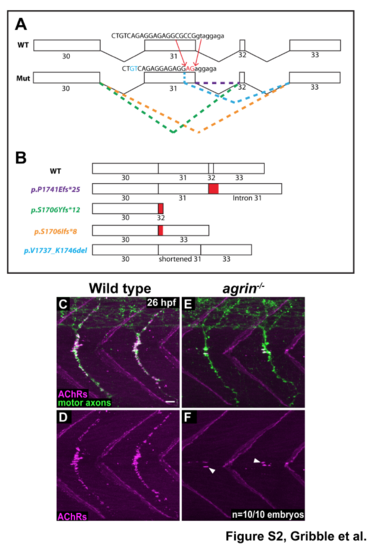Fig. S2
- ID
- ZDB-FIG-180822-59
- Publication
- Gribble et al., 2018 - The synaptic receptor Lrp4 promotes peripheral nerve regeneration
- Other Figures
- All Figure Page
- Back to All Figure Page
|
Zebrafish agrin is required for neuromuscular synapse formation (A) Summary of transcripts generated through CRISPR/Cas9 injection. The allele used for all experiments was a 7bpDEL;2bpINS at the end of exon 31, which resulted in loss of the exon 31 splice donor site. Wild type sequence is flanked by red arrows, and the genomic loss is marked in the mutant sequence just below. Sequencing cDNA from pools of mutants and siblings yielded four predominant transcripts, whose alternative splicing is shown using green, orange, blue, and purple dashed lines. (B) Exon structure and resulting protein sequence for wild type agrin and the four predominant transcripts identified from sequencing cDNA. Three of four transcripts result in a frameshift and premature stop codon (purple, green, and orange transcripts), while one transcript is an in-frame deletion (blue transcript). All four transcripts result in severe swimming defects in zebrafish larvae at 36 hpf (data not shown). (C-D) At 26 hpf in wild type embryos, neuromuscular synapses (AChR labeling in magenta) are abundant beneath motor axons (green). (E-F) In agrin mutants, neuromuscular synapses are significantly reduced; white arrowheads show residual AChR clusters on the muscle cells at the horizontal myoseptum. N = 10 out of 10 embryos analyzed. |

